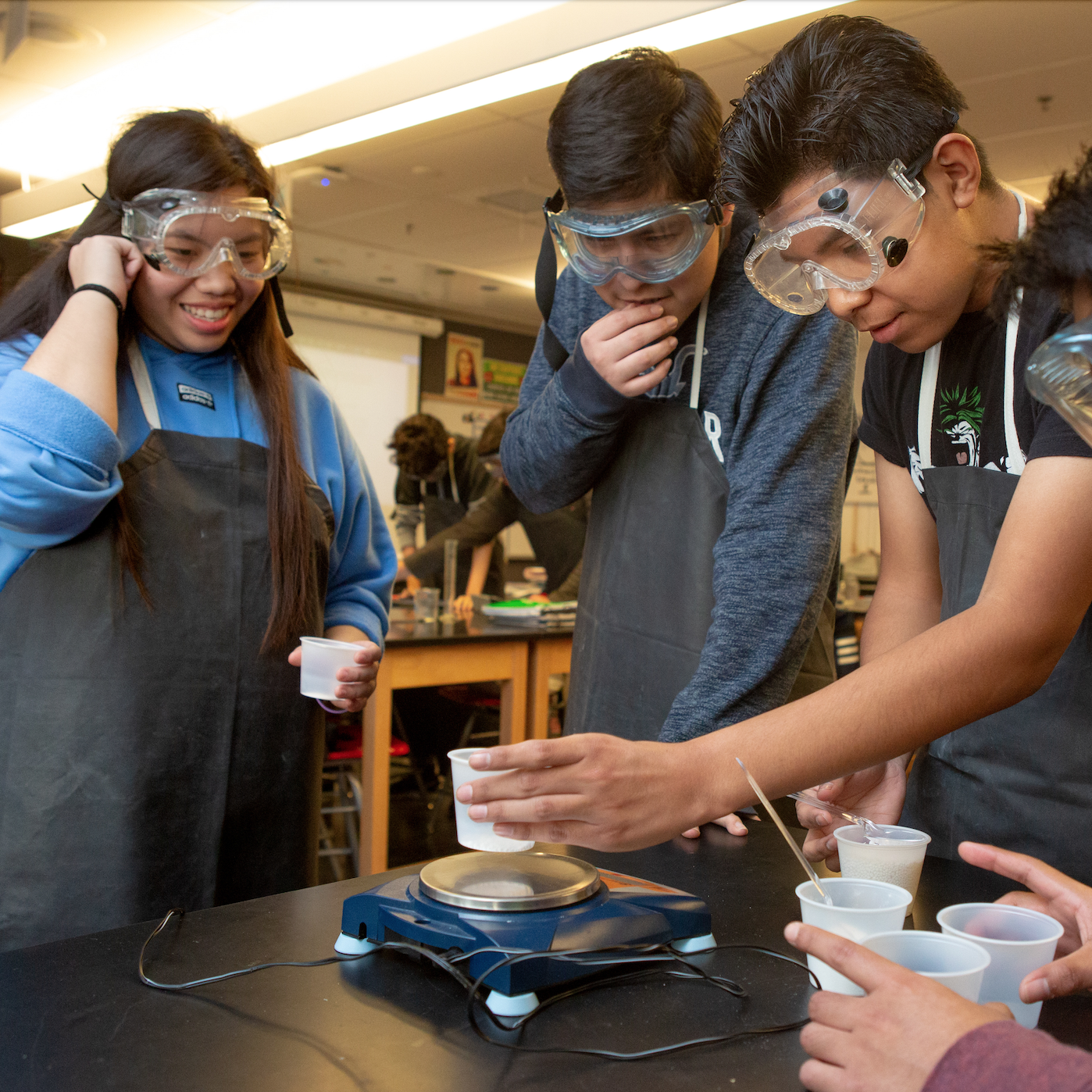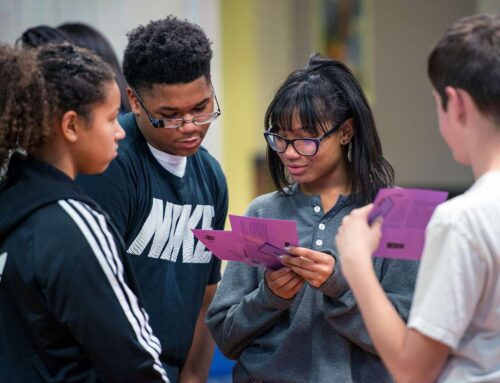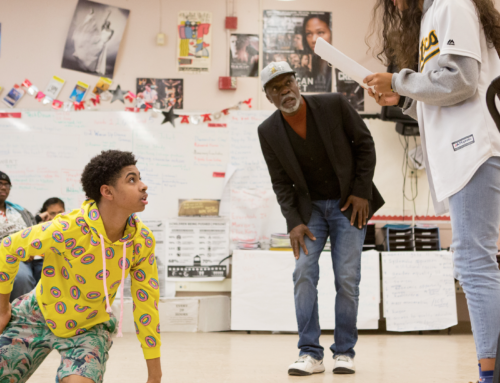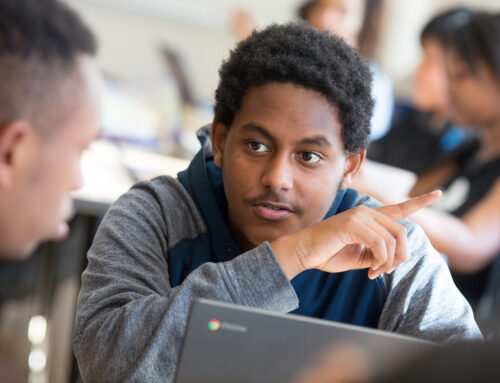Describing a day in the life of a New Village Student is challenging because every student has different goals and interests, different strengths and struggles, and different pathways to successful adulthood! Students will hear no bells and carry no passes. They will always know how the learning they are doing helps them reach their own goals, because they designed their learning plans. And they will always have a respectful adult who knows them well available to answer questions, guide their learning, and push them to dig deeper.
CREW
Students arrive at school by 8:30, hanging out in the Cafe and grabbing breakfast if they arrive early. At 8:30, Crew begins and students spend 45 minutes with the 13 other students and one teacher who have become their school family. They start in a circle, sharing reflections about life and learning, engaging in team-building games, and building their wellness skills. They might also work on their Navigation Plans, the plan they have each crafted with their Navigation Team (including a family member, a community mentor, a peer coach, their internship supervisor, and their Crew Leader).
SKILLS WORKSHOP
The next two hours are work time for academic skills in a flexible structure in Crew rooms, the Learning Commons, or subject area classrooms. Students might be working alone on their computer, with a partner or group, with a teacher, or sometimes in a whole group Math Lab or Language Lab. They are focused on Math skills, English or Spanish language skills, and, once a week, in a Lit Lab (a book club meeting) to discuss interesting books, plays, and articles with their peers.
This a time for students to get extra help if they need it, zoom ahead where they are ready to accelerate, and make sure they are academically ready for college and career. Once they have met state test requirements, they will use this time block to specialize in skills that will help them reach their own college or career goals, develop their passions, and meet Competencies required for graduation.
LUNCH
During Lunch, most students can be found in the Cafe. Some students who have earned the trust of their Crew Leader, Principal, and parent, will be allowed to go to the Mall’s Food Court for lunch or up to the parking deck during nice weather. Lunch is a time to relax and socialize. Microwaves are available for lunches from home and comfortable seating is available in the Learning Commons. Student-run clubs and organizations can also meet during lunch.
COMMUNITY ACTION PROJECTS
In the afternoons, students work in teams with a teacher to make an impact on their community while learning social studies, science, arts, and literacy. They select “CAPs” that match their interests and help them build the skills they need most.
One CAPs block might explore the issue of Gun Violence and what role our government should play in solving it. Students work with the Mayor’s Senior Advisor and Community Activists to research the problem, present solutions to the City Council or State Legislature, and create a museum exhibit of Spoken Word poetry and art that brings youth voices into the conversation.
Another CAP might dig into the problem of Diabetes in Annapolis, investigating with our partner Total Health Care’s public health experts to collect information from across the communities of Annapolis, and developing a city-wide Health Fair to raise awareness about food deserts, healthy lifestyles, and new treatments.
CAPs Block looks different every day – whole class arts-integration lessons, independent computer-based research, expert visitors, a bus ride to do research out in the community or a student-led presentation to a city official.
Older students who have completed at least 5 CAPs may apply to work on Independent Projects, take college classes at AACC, or lead student-run CAPs themselves.
THE END OF THE SCHOOL DAY
Everyone meets back in their crew to help clean up the school at the end of the day. After 3:30 students might head home or to an afterschool job in the Mall. Or they might stick around to engage in a school-sponsored afterschool activity like martial arts, debate team, chorus, or running club. And since Annapolis is our classroom, students might also head out by public bus to community programs with our partners like Maryland Hall, Annapolis Soccer Club, and Seeds for Success where they can continue to grow their skills and contribute evidence to their portfolios for credit. Since learning happens (and “counts”) everywhere, the possibilities are truly endless.
WBL (INTERNSHIPS)
Wednesdays (and sometimes Fridays, too, for Gateway 2 (11th and 12th grade) students) are Work-Based Learning or WBL (pronounced “Wibble”). On those days, most students are off campus – going straight from home to an internship (or apprenticeship) where they log in to let their Crew Leader know they’ve arrived, meet with the Internship Supervisor, and start their workday. They learn new skills from adults in the workplace and work on an independent project to contribute to a need or problem in the business or organization. Their Crew Leader may come for a site visit to check on how things are going.
Students could have internships in government, at local businesses, or at Anne Arundel Medical Center, in fields as different as sound production, environmental engineering, arts-based preschool teaching, auto repair, and marketing.
Students in 9th grade or in transition may not be in a WBL placement. In that case, on Wednesdays they stay with their Crew Leader at school or off campus, working on career exploration and development, learning together, volunteering in the community, job shadowing, or internship-hunting and interviewing for a new WBL position. At 1:00 pm, they are released for Accountable Independent Study (AIS), a planned project or learning task for which they will be accountable in Crew on Thursday morning. Students who aren’t able to see their AIS projects through to completion will be asked to stay at school the next Wednesday afternoon to do their AIS project under staff supervision.
APPRENTICESHIPS (PAID)
Some students in 11th grade know they have found their career passion and a company or organization ready to sponsor them. Those students can apply to transition from an unpaid internship to a committed, paid apprenticeship They begin apprenticing full-time the summer after 11th grade, continue two full days per week in 12th, and then commit to one full year after graduation to complete a 2000-hour apprenticeship. They also work with their Navigation Team to design 144 hours of career-related credentialing coursework to support their hands-on learning and ensure they are ready for a well-paid career at the end of their apprenticeship.
WEEKLY SCHEDULE







